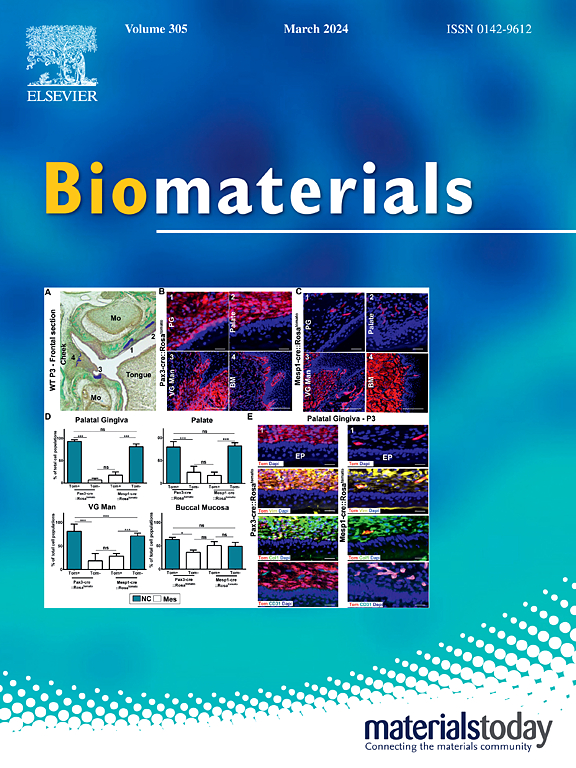Heavy-atom-effect enhanced singlet oxygen generation of carbon dots for lipid-targeting tumor photodynamic therapy inducing ferroptosis
IF 12.9
1区 医学
Q1 ENGINEERING, BIOMEDICAL
引用次数: 0
Abstract
Carbon dots (CDs) have garnered significant attention in the field of tumor photodynamic therapy (PDT) in recent years, attributed to their superior optical properties and favorable biocompatibility. In the research on PDT inducing tumor ferroptosis via lipid peroxidation (LPO), pursuing novel CDs-based photosensitizers (PSs) with higher ROS yield and subcellular structure-lipid targeting capabilities remains a significant challenge. This study presents the design and synthesis of heavy-atom-effect-enhanced CDs PSs specifically tailored for lipid-targeting PDT inducing tumor ferroptosis. Initially, red-emitting CDs (RCDs) doped with fluorine (F), chlorine (Cl), and bromine (Br) were synthesized. Notably, bromine-doped RCDs (Br-RCDs) exhibited remarkable singlet oxygen (1O2) generation capacity, attributed to the heavy-atom effect. Subsequent cellular experiments revealed that Br-RCDs were efficiently internalized by cells and specifically targeted to lipid droplets and cell membranes. Upon light exposure, Br-RCDs generated substantial 1O2, inducing tumor cells LPO accumulation, glutathione peroxidase 4 (GPX4) protein expression downregulation and mitochondrial damage, thereby causing cell ferroptosis. Furthermore, in vivo studies corroborated the notable antitumor efficacy of Br-RCDs-mediated PDT in xenograft tumor models, highlighting its potent ability to induce tumor ferroptosis and exceptional biocompatibility. This research contributes vital insights into the design and synthesis of organelle-targeting, heavy-atom-doped CDs as high-performance photosensitizers, thereby enabling efficient induction of tumor ferroptosis via PDT.
重原子效应增强碳点单线态氧生成用于脂质靶向肿瘤光动力治疗诱导铁下垂
近年来,碳点因其优异的光学性能和良好的生物相容性在肿瘤光动力治疗领域受到广泛关注。在PDT通过脂质过氧化(LPO)诱导肿瘤铁凋亡的研究中,寻求具有更高ROS产率和亚细胞结构-脂质靶向能力的新型基于cds的光敏剂(ps)仍然是一个重大挑战。本研究设计和合成了重原子效应增强的CDs PSs,专门用于脂质靶向PDT诱导肿瘤铁下垂。最初,合成了掺杂氟(F)、氯(Cl)和溴(Br)的红色发光CDs (RCDs)。值得注意的是,由于重原子效应,掺杂溴的RCDs (Br-RCDs)表现出显著的单线态氧(1O2)生成能力。随后的细胞实验表明,Br-RCDs可被细胞有效内化,并特异性靶向脂滴和细胞膜。Br-RCDs在光照下产生大量的1O2,诱导肿瘤细胞LPO积累,谷胱甘肽过氧化物酶4 (glutathione peroxidase 4, GPX4)蛋白表达下调,线粒体损伤,导致细胞铁下垂。此外,体内研究证实了br - rcds介导的PDT在异种移植肿瘤模型中的显著抗肿瘤功效,强调了其诱导肿瘤铁下垂的强大能力和卓越的生物相容性。该研究为设计和合成靶向细胞器的重原子掺杂CDs作为高性能光敏剂提供了重要见解,从而实现了通过PDT有效诱导肿瘤铁凋亡。
本文章由计算机程序翻译,如有差异,请以英文原文为准。
求助全文
约1分钟内获得全文
求助全文
来源期刊

Biomaterials
工程技术-材料科学:生物材料
CiteScore
26.00
自引率
2.90%
发文量
565
审稿时长
46 days
期刊介绍:
Biomaterials is an international journal covering the science and clinical application of biomaterials. A biomaterial is now defined as a substance that has been engineered to take a form which, alone or as part of a complex system, is used to direct, by control of interactions with components of living systems, the course of any therapeutic or diagnostic procedure. It is the aim of the journal to provide a peer-reviewed forum for the publication of original papers and authoritative review and opinion papers dealing with the most important issues facing the use of biomaterials in clinical practice. The scope of the journal covers the wide range of physical, biological and chemical sciences that underpin the design of biomaterials and the clinical disciplines in which they are used. These sciences include polymer synthesis and characterization, drug and gene vector design, the biology of the host response, immunology and toxicology and self assembly at the nanoscale. Clinical applications include the therapies of medical technology and regenerative medicine in all clinical disciplines, and diagnostic systems that reply on innovative contrast and sensing agents. The journal is relevant to areas such as cancer diagnosis and therapy, implantable devices, drug delivery systems, gene vectors, bionanotechnology and tissue engineering.
 求助内容:
求助内容: 应助结果提醒方式:
应助结果提醒方式:


